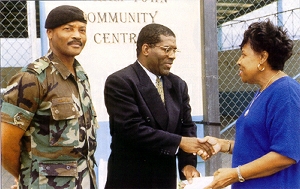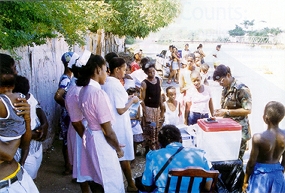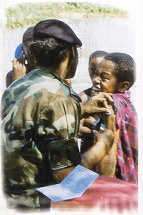|
||||||||||||||||||||||||||||||||||||
| Home > Info Centre > Publications > Alert 1998 > A Strategy that Counts | ||||||||||||||||||||||||||||||||||||
|
|
The fundamental goal of ‘hearts and minds’ activities is to win the support of the populace for the security objectives. In Kingston’s inner city, where security personnel are often regarded as "Babylon," this has to be deliberately pursued. The battle for the "hearts and minds" can be more difficult than winning fire-fights against criminals. The First Battalion (1JR) has taken the matter very seriously and has written standard operating procedures which require Company Commanders to plan and implement specific activities, to win the "hearts and minds" of citizens in their areas of operation. Significant successes were recorded during operations in the Corporate Area. Lessons from the "hearts and minds" strategy used by 1JR during operation DOVETAIL may inform subsequent operations in the inner city. The Role of the Commander Senior commanders demonstrated by example, the required standards of courtesy and respect. The Chief of Staff and the Commanding Officer visited all the companies’ areas of responsibility, and listened to the concerns of the people. Company commanders did likewise on a regular basis. Troops were daily reminded in their briefings to be courteous and respectful. Troops followed the lead. Citizens’ complaints became few and far between. There was also the occasional commendation for professional conduct. These were gladly received and passed down to the troops. Recognition of Local Leadership Credible community leadership is often absent from inner city communities. Where we identified a leader, lines of communication were established between such a person and the Company Commander. This gave the community access to the military hierarchy and vice versa. Our command element obtained access to the centre of influence in the community. Communities were therefore in a position to learn and understand the purpose of the security intervention for their protection. Catering to the Needs of the Community Traditional internal security strategy focuses security protection around the institutions of the state. The inner city conflicts, which have been claiming scores of lives, threaten national security, but not in the direct sense of attack against the state apparatus. Although civil administration, within the confines of the most violence-prone communities, is usually rendered ineffective, it is the community rather than the state, that is directly and immediately vulnerable and in greatest need of protection. With this knowledge, a deliberate effort was made to formulate a strategy with the objective of protecting the community and its residents. Measures of success were modified and patrol tasks detailed accordingly. The change in attitude of our forces did not go unnoticed by residents who responded with smiles and curtailed their hostile looks, gestures and comments. Liaison with social agencies and Non-Governmental Organizations
Traditional ‘hearts and minds’ activities would often see the military taking on social and welfare projects. The Force was never able to sustain these activities or to deliver them to the extent that would surpass tokenism. That approach relied on the supporting services of the JDF, they being already stretched, to cater to the needs of our troops. At the same time, the infanteer patrolling the streets and getting into sticky situations with residents would still be regarded as a different breed -"Babylon". This approach to showing concern for the communities is not sustainable. Hence another method was tried. When engineering assistance was requested to clear bushes on border lines, we organised standing patrols to protect clearing parties from the Public Works Department and as well as local volunteers. We offered similar cover to National Water Commission workers who needed to fix leaks. When a little girl was injured in her leg during an exchange of gunfire between a patrol and armed men in the community, children welfare organizations were informed and a pledge of assistance obtained. A private company was also found to make a small financial contribution to offset some of the mother’s expenses in meeting the child’s needs. Counselling services were sought and obtained from the Caribbean Graduate School of Theology, the aim being to help the little girl deal with the trauma. Instead of stretching the meagre support services of the JDF to cater to community needs, our "hearts and minds" strategy was to place the JDF in the role of facilitator at the level of the Commander, and protector at the level of the foot soldier. This is a strategy that is sustainable, as long as we remain on the streets. If we persist, we may soon be able to make the gunman redundant. This is a preferred alternative to facing him in combat.
Through our strategy, we have touched the hearts of residents and their attitudes towards us have been changing in a positive way. The breakdown in the relationship between the security forces and the communities did not take place overnight. It will take consistent application of a deliberate strategy to protect the ground that has been reclaimed, and eventually to restore a harmonious relationship. The operational success in the battalion Area of Operation in the last quarter of 1997, speaks for the soundness of this strategy and recommends this approach for the future.
|
|||||||||||||||||||||||||||||||||||
|
|
||||||||||||||||||||||||||||||||||||



